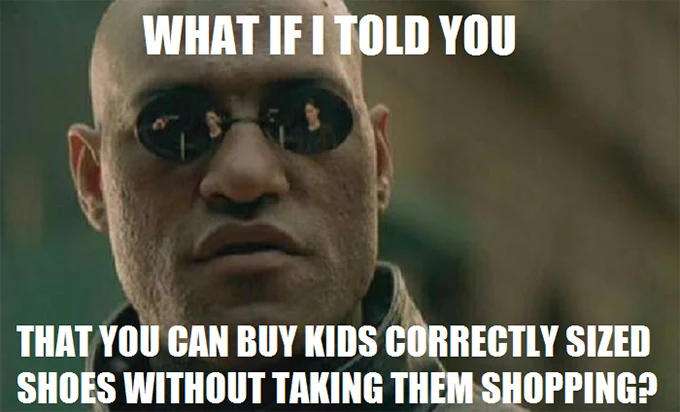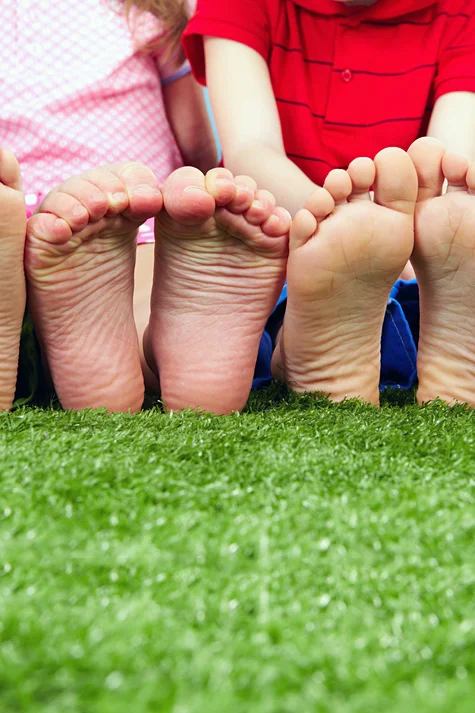The Garage Saler's Ultimate Guide to Buying Kids Shoes
This past August, at a garage sale, I witnessed a mother's worst nightmare: Total Child Meltdown —in public, no less. And it wasn't just one child. All three of this poor woman's young children were lying in a pile of gently used shoes kicking and screaming at the top of their little lungs. It was hard to watch. My heart went out to her.
What's worse is it didn't have to happen. I know a trick that will put an end to Back-to-School shoe shopping tantrums for good. But it wasn't the right time to share it with her.
Instead, I helped the mortified mom pick up scattered shoes and return them to their respective table. She thanked me profusely with her facial expression. I mouthed, "Don't worry. It happens to the best of us."
Which is true.
What is it about shoe shopping that brings out the worst in kids who are otherwise well-behaved?
(To put it mildly.)
I'm not saying that shoe shopping with kids is a nightmare for every parent. Your little one may be an absolute joy to take back-to-school shoe shopping. Mine was. (She's 33 now.)
Still, Corona Virus aside, there are a lot of moms who would rather peel potatoes with a toothpick than drag their kids with them to look for school shoes. And they're not shy about saying so. Take a look at these comments I found on Rants From Mommy Land:
"What is it about the shoe shopping? I thought it was only my toddler. He inevitably wants some random pair of shoes that don't fit or are ugly or something and I end up having to carry him away screaming. " - MJ
"I have 3 y.o. twin boys who are remarkably well behaved on outings....EXCEPT for stinking shoe shopping! The last time, both boys went screaming-in-the-floor, totally-lost-my-schmidt crazy because I wouldn't buy the Dora umbrella and matching purse. You. Are. A. Boy. Dora is for girls. And that $14 umbrella won't last the ride home...geesh." - Erika
"Shoe shopping. My oldest is okay. Now. When he was younger, it was torture. My youngest wants the prettiest, pinkest, sparkliest, light-uppiest, tackiest shoes ever... It's a battle every dang time."
"I don't take my kids [shoe shopping] anymore." - Kirstie
Wait a minute. Just "don't take" kids shopping for school shoes? Is that even an option!?
You may want to sit down for this.
It's an option.
Unless you can't find a sitter, you don't have to take your kids shoe shopping. You're better off taking cardboard replicas of their little feet with you, instead.
Seriously.
If you trace your child's foot on a piece of cardboard, add a half-inch in length and cut it out, you can use the cardboard cut-out to stand in for your kid and "try on" shoes ...all...day...long.
Unlike the living, breathing version, the cardboard foot never gets tired. It doesn't whine or throw temper tantrums and it won't beg you to buy a pair of knock-off Flintstones rainbow-light-up high tops with a picture of Fred on the side that's so small and distorted it looks like he's drunk and winking at Betty Rubble. (True story.)
"The paper foot is typically much better behaved than the real foot, which ... comes with a high pitched whine in my house."
- Susan Maccarelli, peckedtodeathbychickens.com
More importantly, the cardboard foot doesn't fidget or squirm when you're checking shoes for size and the rigid cardboard makes it easy to feel how far down the 'big toe' reaches inside the shoe. Not only that, but the extra half-inch also accounts for wiggle room, so there's very little guesswork involved.
But I understand if you're hesitant.
Ill-fitting shoes are more than simply uncomfortable for a child. Over time wearing the wrong size shoes can lead to bad posture, back pain, bunions, hammer toes, nerve damage, arthritis and a host of other serious problems for kids down the road that you'd do anything to prevent.
And how can you possibly ensure a proper fit if your kids aren't with you to answer important questions like,
"How do those feel?"
"Are they comfortable?"
"Do they rub anywhere or hurt your feet?"
Obviously a cardboard foot can't answer those questions.
But here's the thing.
Neither can our kids —not correctly, anyway.
The Truth About Trying Shoes on Your Kids
The truth is, it's impossible for kids to tell if their shoes fit, or not! Their developing little feet don't have enough nerve endings to feel a difference. Recent studies show, in fact, that children wearing shoes up to five sizes too small still think they fit well.
Not surprisingly, a recent survey found that 65% of kids in the U.S. are wearing shoes that don't fit.
But don't beat yourself up if you discover your kid is one of them.
Trusting our children to tell us when their shoes are too tight doesn't make us bad parents. We do our best with what we know at the time and when we know better, we do better. Right?
Back in the Day
Heck, not long before I was born, shoe stores used a radioactive, cancer-causing x-ray machine called a "Shoe-fitting Fluoroscope" to find the right size shoes for kids.
Before it was banned in the 60's, the Shoe-fitting Fluoroscope allowed shoe salesmen and parents to see a live, moving picture of the bones and flesh of a child's foot inside a desired shoe.
The problem was, it worked by standing children directly on top of an x-ray tube that blasted radiation up through their feet and into their little torsos.
Fortunately, modern alternatives to the Shoe-Fitting Fluoroscope don't move the needle on a Geiger counter.
If the Shoe Fits, Just Do It
Sports shoe giant, Nike recently added a feature to it's shopping app that provides "hyper-accurate" size recommendations specific to Nike shoes by scanning feet with your smartphone camera. Suggested sizes vary with different Nike shoe styles and the data isn't portable, but you can store the foot scan in your profile for future Nike shoe shopping.
Several other mobile shoe shopping apps similar to Nike's are available at the Google Play Store for around $3 and up.
But if you'd rather be more hands on or you're not the least bit tech savvy, I recommend going old school with cardboard feet. It's straightforward and easy. Any Mom (or even dad!) could do it.
Follow these tips to ensure your measurements are accurate.
MEASURING TIPS
-
Trace your kid's feet without shoes and with the same socks to be worn
with the shoes you buy.
-
Trace and measure late in the day. Like adult feet, children's feet
swell and will be larger after playing all day.
- Have your child stand up as you trace.
- Hold the pen straight up as you trace - not at an angle.
-
Keep an eye on your toddler's toes. Toddlers tend to curl toes under
which will throw off your measurement.
- The longest toe is not necessarily the big toe.
- Trace both feet, since one may be larger than the other.
-
Use the measurements from the larger foot to determine the right shoe
size
Now, here's the fun part.
How to Use a Cardboard Foot to Shop for Kids Shoes
Shoe shopping with a cardboard foot is easy peasy. Just compare
the length of the cardboard cut-out to the sole of a shoe you like. If it's
not too short, slip the the cardboard foot inside the shoe to check the fit.
If it lays flat, you have a winner! If the cardboard foot bends, however --
game over. The shoe is too small.
MEASURING TIPS
- Trace your kid's feet without shoes and with the same socks to be worn with the shoes you buy.
- Trace and measure late in the day. Like adult feet, children's feet swell and will be larger after playing all day.
- Have your child stand up as you trace.
- Hold the pen straight up as you trace - not at an angle.
- Keep an eye on your toddler's toes. Toddlers tend to curl toes under which will throw off your measurement.
- The longest toe is not necessarily the big toe.
- Trace both feet, since one may be larger than the other.
- Use the measurements from the larger foot to determine the right shoe size
Now, here's the fun part.
How to Use a Cardboard Foot to Shop for Kids Shoes
Shoe shopping with a cardboard foot is easy peasy. Just compare the length of the cardboard cut-out to the sole of a shoe you like. If it's not too short, slip the the cardboard foot inside the shoe to check the fit. If it lays flat, you have a winner! If the cardboard foot bends, however -- game over. The shoe is too small.
"Give a girl the right pair of shoes and she can conquer the world." - Marilyn Monroe
What To Look For in Kids' Shoes
Now that you know what size to buy, here's what experts say you should look for in kids' shoes:
- Natural materials that breathe such as leather or canvas.
- Soft, flexible soles that mimic natural foot motion.
- Flat bottom shoes for toddlers and flats or heels under an inch tall for bigger kids.
- A wide, round toe box shaped like your child's toes.
- Adjustable Velcro closures, laces or buckles.
- Dress shoes with tread on the soles. Wobbly tots and active kids are likely to slip and fall in shoes with smooth, slick soles.
Shoe Shopping Do's and Don'ts
- Do buy kids' shoes for the larger foot. It's common for kids to have one foot that's as much as an inch longer than the other.
- Do allow an extra half-inch in length for growth.
- Don't buy kids' shoes that are more than one size too large.
- Don’t assume the size on the shoe box or label is accurate, There's no industry standard for kids' shoes, so sizes vary widely.
- Don't buy shoes that need to be "broken in." Kids' shoes should be comfortable from the start.
- Do remember to buy bigger socks when your child goes up a size in shoes.
- Don't forget to try new shoes on your kids at home.
How will I know when my kids have outgrown shoes?
Children usually outgrow their shoes well before the shoes wear out. But seldom, if ever, do kids tug on your shirt; look up at you and declare, “Hey Mom! My sneakers are too tight!” So watch for non-verbal clues instead.
Actions speak louder than words
Wearing shoes that are too small can make kids tired, moody and generally uncooperative. If your son keeps taking off his Nikes every time you turn around, or if he limps or refuses to walk while he's wearing them -- uncomfortable, ill-fitting shoes are likely the culprit. Or if your daughter cries or wriggles away when you try to put her loafers on for her, it's probably time to go up a size.
Your children's feet can tell you what they don't
Of course, not all kids wince in pain or act out when their shoes don't fit. So it's important to periodically check your children's bare feet for any problems caused by ill-fitting foot attire. Redness, calluses, blisters and imprints can all be signs it's time to go up a size.
Shoes speak volumes
You should also check your kid's shoes every few months for signs of excess wear. If the sides are bulging, the shoes may be too narrow. Toes that bend upward are a sign that shoes are too short. Excessive wear around the side or the heel, scuffed or torn toes and ripped linings are all signs you should purchase new shoes for your children.
TIP: The smaller the foot, the faster it grows.
HOW OFTEN SHOULD YOU CHECK YOUR KIDS SHOES?
Age 0 - 18 mosCheck the fit of your kids' shoes every 1 – 2 months
Age 18 -24 mosCheck the fit of your kids' shoes every 2 – 3 months
Age 2 - 3 yearsCheck the fit of your kids' shoes every 3 – 4 months
Age 3 years and upCheck the fit of your kids' shoes every 4 – 6 months
... and now to address the elephant in the room ...
What About Buying Used Shoes at a Thrift Store or Garage Sale?
I hope this helps!
— Thank You for Reading
Resources:
Recent:
- CRAIGSLIST TIPS: How to find distressed sellers and dirt-cheap deals on stuff you actually want to buy
- Funny Craigslist Ads: That's Cold Dude!
- '101 Freebies To Give Away In Your Free Box
- Cheap DIY Signs That People Won't Ignore (+ How To Make Them)
- Part II: Cheap DIY Signs That People Won't Ignore
- 400+ Irresistible Headlines - From Traditional to Irreverent
OKC Craigslist Garage Sale Blog — Oklahoma City | CRAIGSLIST-GARAGE-SALES.COM
Permalink - https://okc-craigslist.blogspot.com/2022/11/ultimate-guide-buying-kids-shoes-used.html
Tips • Signs • Finds • Garage Sales • Price Guides • DIY • OKC Craigslist




















